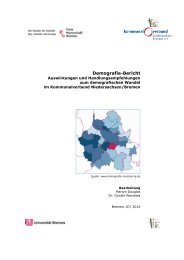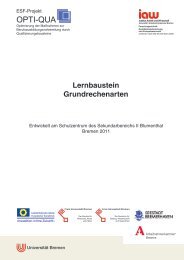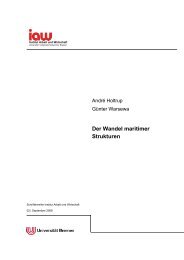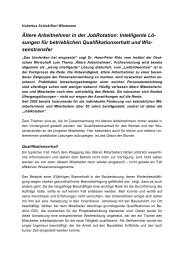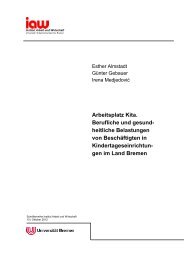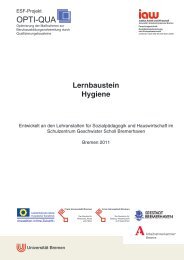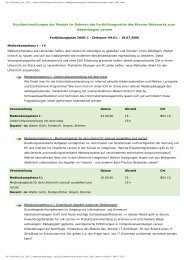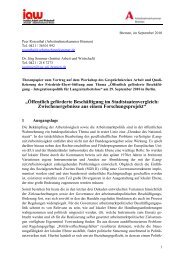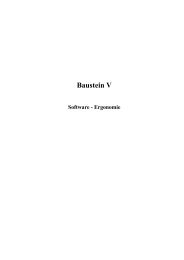Knowledge Spillovers in different Dimensions of Proximity
Knowledge Spillovers in different Dimensions of Proximity
Knowledge Spillovers in different Dimensions of Proximity
You also want an ePaper? Increase the reach of your titles
YUMPU automatically turns print PDFs into web optimized ePapers that Google loves.
<strong>Knowledge</strong> <strong>Spillovers</strong> <strong>in</strong> <strong>different</strong> <strong>Dimensions</strong> <strong>of</strong> <strong>Proximity</strong><br />
Wiebke Lang<br />
University <strong>of</strong> Bremen, Institute Labour and Economy<br />
Paper presented at the Regional Studies Association International Conference<br />
“Regional Growth Agendas”, 28 th May to 31 st May 2005 <strong>in</strong> Aalborg<br />
Gateway 5 “Mean<strong>in</strong>g and Role <strong>of</strong> <strong>Proximity</strong>”<br />
Contact:<br />
Dipl. Ing<br />
Wiebke Lang<br />
University <strong>of</strong> Bremen | IAW (Institute Labour and Economy)<br />
Parkallee 39<br />
28209 Bremen<br />
Germany<br />
phone: +49 (0)471 218 7273<br />
fax: +49 (0)471 218 2680<br />
email: wlang@iaw.uni-bremen.de<br />
url: www.iaw.uni-bremen.de
<strong>Knowledge</strong> <strong>Spillovers</strong> <strong>in</strong> <strong>different</strong> <strong>Dimensions</strong> <strong>of</strong> <strong>Proximity</strong> Wiebke Lang<br />
<strong>Knowledge</strong> <strong>Spillovers</strong> <strong>in</strong> <strong>different</strong> <strong>Dimensions</strong> <strong>of</strong> <strong>Proximity</strong><br />
At a first glance proximity seems to be a very mean<strong>in</strong>gful concept, as it has found its way <strong>in</strong>to<br />
many policy concepts for regional development. Most regional, national and supranational<br />
development programs for regional growth elaborate factors such as the proximity <strong>of</strong> university<br />
and high-tech firms, the proximity <strong>of</strong> researchers or the proximity <strong>of</strong> similar sectors <strong>of</strong><br />
economic activity.<br />
Tak<strong>in</strong>g a closer look, proximity looses mean<strong>in</strong>g. Theoretical and empirical approaches use the<br />
concept <strong>in</strong> many dimensions: organisational, technological, <strong>in</strong>dustrial, cultural, geographical,<br />
cognitive, <strong>in</strong>stitutional proximity. Without be<strong>in</strong>g exact about the dimension used, proximity is<br />
what Ann Markusen (1999) would call a fuzzy concept.<br />
Nevertheless, <strong>in</strong> all these dimensions proximity apparently plays a significant role for the <strong>in</strong>novativeness<br />
<strong>of</strong> economic actors, because it promotes and facilitates knowledge spillovers.<br />
“<strong>Proximity</strong> <strong>in</strong> geographical, <strong>in</strong>dustrial, and technical space matters here <strong>in</strong> that it provides<br />
reluctant and sceptic, risk-adverse adopters the opportunity to assess the actual pr<strong>of</strong>itability<br />
<strong>of</strong> the new technology and hence to adopt it.” (Antonelli 2003: 9-10) A central question is<br />
therefore the relationship between geographical proximity and other dimensions <strong>of</strong> proximity.<br />
Do they serve as substitutes or as complements to geographical proximity (Boschma 2005)<br />
and how does this relationship <strong>in</strong>fluence knowledge spillovers and regional growth.<br />
Undertak<strong>in</strong>g research on knowledge spillovers faces the problem that no conclud<strong>in</strong>g theory <strong>of</strong><br />
the <strong>in</strong>novation process exists that could expla<strong>in</strong> the causes, impacts and distribution mechanisms<br />
<strong>of</strong> knowledge spillovers <strong>in</strong> macroeconomic terms. Research on the allocation and distribution<br />
<strong>of</strong> the classic factors <strong>of</strong> production land, capital and labour have a long tradition.<br />
<strong>Knowledge</strong> as an essential production factor found only sporadic attention for example by<br />
Marshall 1890 or Hayek 1945. Inasmuch as the western <strong>in</strong>dustrial countries found themselves<br />
loos<strong>in</strong>g ground compet<strong>in</strong>g <strong>in</strong> the classic factors <strong>of</strong> production, the ‘new’ production factor<br />
knowledge as their competitive advantage was discovered. Accord<strong>in</strong>gly, research on the role<br />
<strong>of</strong> knowledge extensively took up.<br />
S<strong>in</strong>ce the mid 90ies an astonish<strong>in</strong>g th<strong>in</strong>g can be observed. Research results are <strong>of</strong>ten greedily<br />
taken up by policy measures although conclud<strong>in</strong>g evidence is still miss<strong>in</strong>g. And research uncritically<br />
takes up poorly conceived ideas, legitimis<strong>in</strong>g the policy concepts ex post. “The lack<br />
<strong>of</strong> precise understand<strong>in</strong>g is <strong>in</strong> stark contrast to the many policies and policy oriented concepts<br />
that attempt to utilize the positive impulses <strong>of</strong> knowledge spillovers.” (Maier & Sedlacek<br />
2005: 1)<br />
Especially the thesis that spatial proximity facilitates the distribution and accumulation <strong>of</strong> the<br />
alleged only competitive advantage knowledge, f<strong>in</strong>ely fits <strong>in</strong>to policy concepts, that demand<br />
more responsibility <strong>of</strong> regions and cities for their own economic welfare. This on the one hand<br />
Regional Growth Agendas 28th to 31st May 2005, Aalborg 2
<strong>Knowledge</strong> <strong>Spillovers</strong> <strong>in</strong> <strong>different</strong> <strong>Dimensions</strong> <strong>of</strong> <strong>Proximity</strong> Wiebke Lang<br />
allows central <strong>in</strong>stitutions to <strong>of</strong>fload responsibility and redistribution requirements. On the<br />
other hand it is a tribute to the decrease <strong>of</strong> steer<strong>in</strong>g capacity <strong>in</strong> the face <strong>of</strong> grow<strong>in</strong>g complexity.<br />
In effect regional competition is furthered thereby accept<strong>in</strong>g <strong>in</strong>creas<strong>in</strong>g divergence between<br />
regions.<br />
So the precise understand<strong>in</strong>g <strong>of</strong> the mean<strong>in</strong>g <strong>of</strong> spatial proximity for knowledge spillovers and<br />
the way these <strong>in</strong>sights are fed <strong>in</strong>to policy concepts are crucial. The accurate def<strong>in</strong>ition <strong>of</strong><br />
mechanisms and proximity dimensions facilitat<strong>in</strong>g knowledge spillovers is necessary to identify<br />
the endogenous potential <strong>of</strong> regions to facilitate knowledge driven economic processes.<br />
Additionally rema<strong>in</strong><strong>in</strong>g demands for redistribution and central govern<strong>in</strong>g can be specified to<br />
enable an overall cohesive development process.<br />
Tak<strong>in</strong>g a closer look at the orig<strong>in</strong>al theories I will firstly work out what contribution the three<br />
central theories actually make to the mean<strong>in</strong>g <strong>of</strong> proximity for knowledge spillovers. This will<br />
be followed by an def<strong>in</strong>ition <strong>of</strong> four dimensions <strong>of</strong> proximity that provide essential explanation<br />
<strong>of</strong> the mechanisms responsible for knowledge spillovers. The analysis <strong>of</strong> their relationship<br />
will show what role spatial proximity really plays for knowledge spillovers.<br />
<strong>Proximity</strong> <strong>in</strong> the New Growth Theory<br />
The New Growth Theory shows, that the <strong>in</strong>put <strong>of</strong> knowledge <strong>in</strong> the production process provokes<br />
<strong>in</strong>creas<strong>in</strong>g returns. These do not occur to the advantage <strong>of</strong> a s<strong>in</strong>gle firm or human be<strong>in</strong>g,<br />
but to an <strong>in</strong>dustry or to an economic system altogether. Tak<strong>in</strong>g localisation and urbanisation<br />
economies <strong>in</strong>to account, it is postulated, that not every actor benefits from these <strong>in</strong>creas<strong>in</strong>g<br />
returns, but those who are <strong>in</strong> proximity to the knowledge producer. Be<strong>in</strong>g near the<br />
knowledge producer is an advantage because there are greater possibilities to watch, learn<br />
and judge the new ideas. The higher the proximity between actors is, the lower are transaction<br />
and communication costs. By hav<strong>in</strong>g the possibility to learn and anticipate new ideas<br />
quicker than competitors <strong>in</strong> greater distance, proximity turns out to be a competitive advantage.<br />
This is empirically tested with the knowledge production function. Most research results are<br />
supportive <strong>of</strong> this thesis, as they f<strong>in</strong>d a statistical <strong>in</strong>ter-correlation between the density or<br />
amount <strong>of</strong> knowledge <strong>in</strong>put (researchers, universities…) and <strong>in</strong>novation output (patent, new<br />
products…). But the statistical <strong>in</strong>terrelationship does not prove an <strong>in</strong>terdependence <strong>of</strong> spatial<br />
proximity <strong>of</strong> knowledge <strong>in</strong>put and <strong>in</strong>novation output.<br />
The authors <strong>of</strong> the New Growth Theory f<strong>in</strong>d, that there are two components <strong>of</strong> knowledge: a<br />
codified form and a technological form. The term technological knowledge <strong>in</strong>dicates, that this<br />
k<strong>in</strong>d <strong>of</strong> knowledge exhibits technological external economies <strong>of</strong> scale. In effect “for an <strong>in</strong>dividual<br />
firm, average costs per unit <strong>of</strong> output decrease with grow<strong>in</strong>g output at the <strong>in</strong>dustrywide<br />
level.” (van Stel & Nieuwenhuijsen 2004: 405, note 2) In order to benefit from knowl-<br />
Regional Growth Agendas 28th to 31st May 2005, Aalborg 3
<strong>Knowledge</strong> <strong>Spillovers</strong> <strong>in</strong> <strong>different</strong> <strong>Dimensions</strong> <strong>of</strong> <strong>Proximity</strong> Wiebke Lang<br />
edge spillovers as technological externalities ‘<strong>in</strong>dustrial proximity’ is necessary. This means<br />
the production processes <strong>of</strong> two economic actors must comply to some degree with each other<br />
so that the appropriation <strong>of</strong> knowledge spillovers is possible.<br />
The technological component <strong>of</strong> knowledge <strong>in</strong> the New Growth Theory is generally identified<br />
as tacit knowledge. Tacit knowledge is known to be transferred face-to-face. This gives the<br />
explanation for the statistical <strong>in</strong>ter-correlation <strong>of</strong> <strong>in</strong>novation <strong>in</strong>put and <strong>in</strong>novation output<br />
accounted for by us<strong>in</strong>g the knowledge production function. A theoretical explanation for the<br />
statistical <strong>in</strong>terrelationship is found, so that <strong>in</strong>terdependence can be postulated.<br />
But tacit knowledge and technological knowledge are not the same th<strong>in</strong>gs. It is central to the<br />
New Growth Theory that technological knowledge features the properties <strong>of</strong> externalities. Only<br />
if the knowledge spillovers are externalities they can contribute to a knowledge stock from<br />
which a whole <strong>in</strong>dustry or a regional economic system can benefit. Externalities are non rival<br />
and non-excludable <strong>in</strong> consumption, and they are not transferred <strong>in</strong>tentionally nor mediated<br />
by the price mechanism. This means they are accessible for anyone at any time and any place.<br />
Without this assumption knowledge <strong>in</strong> the production process could not generate <strong>in</strong>creas<strong>in</strong>g<br />
returns.<br />
Table 1: <strong>Knowledge</strong> as Externalitiy and Tacit <strong>Knowledge</strong><br />
<strong>Knowledge</strong> as Externality<br />
non-rival<br />
non-excludable<br />
un-<strong>in</strong>tentional dissem<strong>in</strong>ation<br />
no price mechanism<br />
Tacit <strong>Knowledge</strong><br />
partly rival<br />
partly excludable<br />
<strong>in</strong>tentional dissem<strong>in</strong>ation<br />
no price mechanism<br />
In contrast tacit knowledge does not necessarily show these attributes. Tacit knowledge is<br />
embedded <strong>in</strong> human capital or <strong>in</strong> other production factors. Therefore it must at least partly<br />
take on their properties. But the human capital <strong>of</strong> labourers or the expertise <strong>in</strong>corporated <strong>in</strong><br />
mach<strong>in</strong>es are ord<strong>in</strong>ary private goods. Hence rivalry will characterise at least to some extent<br />
the transference <strong>of</strong> tacit knowledge and maybe <strong>in</strong>terested economic actors will be excluded. A<br />
person who carries tacit knowledge cannot convey it <strong>in</strong>dependently <strong>of</strong> his or her location nor<br />
will the person convey it to anyone regardless <strong>of</strong> the relationship between him and the person<br />
<strong>in</strong>terested <strong>in</strong> acquir<strong>in</strong>g the tacit knowledge.<br />
Nevertheless the appropriation <strong>of</strong> technological knowledge and <strong>of</strong> tacit knowledge is costly.<br />
The transactions costs the recipient must raise can be reduced by spatial proximity. In the<br />
logic <strong>of</strong> tacit knowledge the cost reduction by generat<strong>in</strong>g spatial proximity is possible because<br />
Regional Growth Agendas 28th to 31st May 2005, Aalborg 4
<strong>Knowledge</strong> <strong>Spillovers</strong> <strong>in</strong> <strong>different</strong> <strong>Dimensions</strong> <strong>of</strong> <strong>Proximity</strong> Wiebke Lang<br />
it can only be transferred face-to-face. Spatial proximity is then a prerequisite for the distribution<br />
<strong>of</strong> knowledge.<br />
In the logic <strong>of</strong> technological knowledge the higher probability <strong>of</strong> meet<strong>in</strong>g and communicat<strong>in</strong>g<br />
leads to reduced transaction costs <strong>in</strong> spatial proximity. So be<strong>in</strong>g located <strong>in</strong> a density <strong>of</strong> economic<br />
actors can be a competitive advantage. But as far as the New Growth Theory is concerned<br />
only <strong>in</strong>dustrial proximity is a prerequisite for the distribution <strong>of</strong> knowledge spillovers.<br />
The mutual understand<strong>in</strong>g and consistency <strong>of</strong> production specifications are necessary to benefit<br />
from knowledge spillovers.<br />
<strong>Proximity</strong> <strong>in</strong> the Evolutionary Theory<br />
The Evolutionary Theory also assumes that <strong>in</strong>creas<strong>in</strong>g economies <strong>of</strong> scale are generated by<br />
dynamic, technological externalities <strong>of</strong> scale, which show their impact only <strong>in</strong> an <strong>in</strong>dustry as a<br />
whole. Unlike static externalities, knowledge spillovers as dynamic externalities cont<strong>in</strong>uously<br />
have <strong>in</strong>fluence on production costs and conditions <strong>of</strong> other economic actors. <strong>Knowledge</strong> exhibits<br />
dynamic externalities, because <strong>of</strong> its cumulative character. The fact that new knowledge<br />
builds upon knowledge acquired previously and by others, means that the production function<br />
<strong>of</strong> <strong>different</strong> firms <strong>in</strong> the economic system are dependent on each other. Returns on <strong>in</strong>vestments<br />
<strong>in</strong> knowledge can only be appropriated by the <strong>in</strong>dustry as a whole not by a s<strong>in</strong>gle actor.<br />
So also the Evolutionary Theory postulates what I have co<strong>in</strong>ed earlier <strong>in</strong>dustrial proximity as<br />
an important feature enabl<strong>in</strong>g knowledge spillovers.<br />
An <strong>in</strong>dustry which features not only <strong>in</strong>dustrial proximity but also spatial proximity, <strong>in</strong> other<br />
words an <strong>in</strong>dustry agglomeration, can form a local monopoly by <strong>in</strong>ternalis<strong>in</strong>g the dynamic<br />
technological externalities. The proximity between the economic actors is then so high, that<br />
their comb<strong>in</strong>ed knowledge forms a local knowledge stock.<br />
The regional economy is able to appropriate monopoly rents because <strong>of</strong> the mechanisms <strong>of</strong><br />
cumulative causation which come to effect <strong>in</strong> agglomerations. Here the <strong>in</strong>dustrial effects <strong>of</strong><br />
cumulative causation described by Myrdal and Perroux work together with the cumulative<br />
character <strong>of</strong> knowledge. <strong>Knowledge</strong> spillovers appear <strong>in</strong> the Evolutionary Theory as a specific<br />
type <strong>of</strong> agglomeration effect. This means they can occur <strong>in</strong> agglomerations but spatial proximity<br />
is no sufficient condition for knowledge spillovers.<br />
Regional Growth Agendas 28th to 31st May 2005, Aalborg 5
<strong>Knowledge</strong> <strong>Spillovers</strong> <strong>in</strong> <strong>different</strong> <strong>Dimensions</strong> <strong>of</strong> <strong>Proximity</strong> Wiebke Lang<br />
Figure 1: <strong>Knowledge</strong> <strong>Spillovers</strong> <strong>in</strong> the Systematic <strong>of</strong> Agglomeration Effects<br />
Agglomeration Effects<br />
Agglomeration Economies<br />
Agglomeration Diseconomies<br />
static<br />
(Pool<strong>in</strong>g; Market size)<br />
dynamic<br />
(<strong>Knowledge</strong> Spillover)<br />
Congestion Pollution High Rents<br />
Internal Effects<br />
(<strong>in</strong> the firm)<br />
External Effects<br />
(between firms)<br />
Localisation<br />
Economies<br />
Urbanisation<br />
Economies<br />
Marshall-Arrow-<br />
Romer Externalities<br />
(same <strong>in</strong>dustry) (<strong>different</strong> Industries) (between firms <strong>of</strong><br />
the same <strong>in</strong>dustry)<br />
Jacobs Externalities<br />
(between firms <strong>of</strong><br />
<strong>different</strong> <strong>in</strong>dustries)<br />
Location and Division <strong>of</strong> Labour<br />
Growth and Productivity<br />
The cumulative character <strong>of</strong> knowledge makes cognitive proximity <strong>of</strong> the firms and the <strong>in</strong>dividual<br />
human capital <strong>of</strong> their employees a prerequisite for knowledge distribution. Without<br />
hav<strong>in</strong>g a similar knowledge level I will not be able to understand new knowledge be<strong>in</strong>g presented<br />
to me. In terms <strong>of</strong> firms appropriat<strong>in</strong>g knowledge spillovers, cognitive proximity also<br />
means comply<strong>in</strong>g with a certa<strong>in</strong> composition <strong>of</strong> production factors. Otherwise the appropriation<br />
<strong>of</strong> the new ideas is not possible or too costly. I will co<strong>in</strong> this compliance <strong>of</strong> production<br />
factor composition technological proximity 1 . If human capital relies on cognitive proximity,<br />
firms rely on technological proximity.<br />
As prerequisite for knowledge spillovers the Evolutionary Theory po<strong>in</strong>ts out <strong>in</strong>dustrial proximity<br />
and cognitive or technological proximity depend<strong>in</strong>g on who is communicat<strong>in</strong>g firms or<br />
<strong>in</strong>dividuals. Spatial proximity alone does not have any effects. But co<strong>in</strong>cid<strong>in</strong>g with the other<br />
two proximity effects it may generate monopoly rents for a regional <strong>in</strong>dustry agglomeration.<br />
Network Theory<br />
In the Network Theory knowledge is distributed <strong>in</strong> systems <strong>of</strong> relationships. Their construction<br />
is facilitated by spatial proximity and <strong>in</strong> spatial proximity special modes <strong>of</strong> relationships are<br />
shaped. Especially the exchange <strong>of</strong> tacit knowledge requires direct face–to–face relationships.<br />
Spatial proximity allows frequent encounters which produce common identity, reputation and<br />
1<br />
Giovanni Dosi asserts that firms potentially adopt<strong>in</strong>g knowledge do not, because they simply lack the technological<br />
and organisational capabilities to do so. These factors <strong>in</strong>fluenc<strong>in</strong>g the diffusion <strong>of</strong> <strong>in</strong>novation relate to<br />
technological asymmetries between firms. (Dosi 2000(1991): 123)<br />
Regional Growth Agendas 28th to 31st May 2005, Aalborg 6
<strong>Knowledge</strong> <strong>Spillovers</strong> <strong>in</strong> <strong>different</strong> <strong>Dimensions</strong> <strong>of</strong> <strong>Proximity</strong> Wiebke Lang<br />
trust. In relationships characterised by mutual trust the knowledge distributed and saved <strong>in</strong><br />
them is a public good — a regional knowledge stock. On the regional level <strong>different</strong> forms <strong>of</strong><br />
relationships can be shaped because the reputation <strong>of</strong> economic actors is known and opportunistic<br />
behaviour is impeded.<br />
In the concept <strong>of</strong> <strong>in</strong>novative milieu, it is <strong>different</strong>iated between two sets <strong>of</strong> effects operat<strong>in</strong>g<br />
simultaneously: proximity effects, such as reductions <strong>in</strong> costs because <strong>of</strong> quicker circulation <strong>of</strong><br />
<strong>in</strong>formation, face-to-face contacts, and lower costs <strong>of</strong> collect<strong>in</strong>g <strong>in</strong>formation; and socialization<br />
effects, related to collective learn<strong>in</strong>g, cooperation, and socialization <strong>of</strong> risks. (Malecki & O<strong>in</strong>as<br />
1999: 7)<br />
Although it is emphasised, that these effects are collective rather than explicitly cooperative,<br />
bilateral relationships are the fundament which make it possible for the milieu effect such as<br />
knowledge spillovers to spread beyond any s<strong>in</strong>gle bilateral <strong>in</strong>ter-firm l<strong>in</strong>kage. <strong>Knowledge</strong><br />
<strong>Spillovers</strong> as externality are bound to a specific composition <strong>of</strong> economic actors. The knowledge<br />
stock presents itself as a system <strong>of</strong> connected elements.<br />
“The space or territory <strong>of</strong> a milieu embodies the actors, their <strong>in</strong>teractions and relationships a<br />
multifaceted system that the metric <strong>of</strong> distance alone is unable to capture." (Malecki & O<strong>in</strong>as<br />
1999: 7)<br />
So it is very important to keep <strong>in</strong> m<strong>in</strong>d, that the regional knowledge stock is bound to relationships<br />
and is <strong>in</strong> this respect no real public good. It is not accessible to anyone <strong>in</strong> a region,<br />
but only to those economic actors <strong>in</strong>volved <strong>in</strong> certa<strong>in</strong> (regional) networks. Economic actors <strong>in</strong><br />
spatial proximity are excluded from the knowledge stock by lack<strong>in</strong>g cognitive proximity. Not<br />
the spatial proximity, but the direct connection between actors <strong>in</strong>corporat<strong>in</strong>g relevant knowledge<br />
provides for the dissem<strong>in</strong>ation and production <strong>of</strong> new knowledge. Nevertheless the Network<br />
Theory assumes that <strong>in</strong> spatial proximity more and better l<strong>in</strong>kages between economic<br />
actors exist, which form the competitive advantage <strong>of</strong> spatial proximity for knowledge <strong>in</strong>tensive<br />
processes.<br />
But the emphasis on relationships <strong>in</strong>troduces another proximity dimension I will term behavioural<br />
proximity. Behavioural proximity is a set <strong>of</strong> rules and rout<strong>in</strong>es — explicit or implicit —<br />
which allow <strong>in</strong>dividuals to be co-ord<strong>in</strong>ated without hav<strong>in</strong>g to def<strong>in</strong>e beforehand how they<br />
must do it. Behavioural proximity comprises the non-market content <strong>of</strong> relationships. In that<br />
way it describes the variety <strong>of</strong> concepts such as untraded <strong>in</strong>terdependencies (Storper 1995),<br />
relational capital (Storper 1997), social capital (Putnam 1993), <strong>in</strong>stitutional thickness (Am<strong>in</strong><br />
& Thrift 1994) etc.<br />
In the Network Theory spatial proximity is effective only if it co<strong>in</strong>cides with the existence <strong>of</strong><br />
relationships. “Whereas at the opposite extreme, one can imag<strong>in</strong>e <strong>in</strong>dividuals develop<strong>in</strong>g <strong>in</strong>formal<br />
<strong>in</strong>teractions without be<strong>in</strong>g physically close.” (Rallet & Torre 1999: 375)<br />
Regional Growth Agendas 28th to 31st May 2005, Aalborg 7
<strong>Knowledge</strong> <strong>Spillovers</strong> <strong>in</strong> <strong>different</strong> <strong>Dimensions</strong> <strong>of</strong> <strong>Proximity</strong> Wiebke Lang<br />
<strong>Dimensions</strong> <strong>of</strong> proximity<br />
The analysis <strong>of</strong> the three relevant theories concern<strong>in</strong>g knowledge production and diffusion has<br />
brought up four proximity dimensions that are relevant for knowledge spillovers: Spatial proximity,<br />
technological or <strong>in</strong>dustrial proximity, cognitive proximity and behavioural proximity.<br />
Other authors present various other def<strong>in</strong>itions <strong>of</strong> proximity. In order to outl<strong>in</strong>e the scope <strong>of</strong><br />
the <strong>different</strong> def<strong>in</strong>itions I will hold the four here presented def<strong>in</strong>itions aga<strong>in</strong>st two <strong>different</strong><br />
classifications presented recently <strong>in</strong> a special issue <strong>of</strong> Regional Studies.<br />
Concern<strong>in</strong>g spatial or geographical proximity no contradictions arise, as there is wide agreement,<br />
that it “expresses the kilometric distance between two units” (Torre & Rallet 2005: 49).<br />
Nevertheless be<strong>in</strong>g near or far is no objective kilometric measure. It is weighted by the cost<br />
and time <strong>of</strong> transport as well as by <strong>in</strong>dividual perceptions <strong>of</strong> distance. In spatial proximity the<br />
probability <strong>of</strong> <strong>in</strong>teraction is higher. Although the spatial proximity dimension reduces space<br />
on its physical content, it is not the same as the conta<strong>in</strong>er space <strong>of</strong>ten used <strong>in</strong> economics. So<br />
it also cannot simply be compared to a region delimited by political, adm<strong>in</strong>istrative or functional<br />
frontiers. The geographical proximity <strong>of</strong> two metropoles may be similar to the spatial<br />
proximity <strong>of</strong> the <strong>in</strong>ner city to its suburb depend<strong>in</strong>g on transport <strong>in</strong>frastructure. The advantage<br />
<strong>of</strong> be<strong>in</strong>g located <strong>in</strong> an agglomeration with a transport hub is the possibility <strong>of</strong> temporal spatial<br />
proximity to a relevant person carry<strong>in</strong>g knowledge.<br />
Cognitive proximity is also mentioned by many other authors, although Torre and Rallet subsume<br />
this proximity dimension under the category <strong>of</strong> organisational proximity. Similarity <strong>of</strong><br />
the knowledge base <strong>of</strong> two actors is necessary for mutual understand<strong>in</strong>g. If the cognitive distance<br />
is too big, <strong>in</strong>dividuals will not be able to understand each other or the costs to overcome<br />
knowledge gaps will be too high. On the other hand when two actors are too near no<br />
progress <strong>in</strong> produc<strong>in</strong>g new knowledge will be achieved. All authors agree that cognitive proximity<br />
is a prerequisite for knowledge dissem<strong>in</strong>ation and production. Cowan, David & Foray<br />
(2000) emphasis here the role <strong>of</strong> epistemological communities. Referr<strong>in</strong>g to the technical<br />
jargon <strong>of</strong> pr<strong>of</strong>essionals they f<strong>in</strong>d that knowledge is transferred <strong>in</strong> specific codebooks, which<br />
are only known to experts <strong>of</strong> a scientific field. They can communicate with each other over<br />
great distance by means <strong>of</strong> articles and conferences, while actors without knowledge <strong>of</strong> the<br />
codebook are excluded. Firms can form epistemological communities with their suppliers and<br />
customers, oriented narrowly towards a certa<strong>in</strong> common project. Spatial proximity can then<br />
occur as result <strong>of</strong> the formation <strong>of</strong> epistemological communities. In research projects and<br />
visits, conferences, bus<strong>in</strong>ess meet<strong>in</strong>gs etc. spatial proximity is established temporarily. Empirical<br />
studies by Maryann Feldman and Lichtenberg underl<strong>in</strong>e these mechanisms. They analyse<br />
research projects with the actors <strong>in</strong>volved located at <strong>different</strong> places <strong>in</strong> the EU. Centralisation<br />
<strong>of</strong> the members at one location occurs accord<strong>in</strong>g to the amount <strong>of</strong> tacit knowledge that is<br />
generated. So cognitive proximity leads to spatial proximity and may be ended when the<br />
knowledge level is adjusted. Freel (2003) shows that with the means <strong>of</strong> (temporal) spatial<br />
Regional Growth Agendas 28th to 31st May 2005, Aalborg 8
<strong>Knowledge</strong> <strong>Spillovers</strong> <strong>in</strong> <strong>different</strong> <strong>Dimensions</strong> <strong>of</strong> <strong>Proximity</strong> Wiebke Lang<br />
proximity knowledge gaps, that actually prevent two actors from understand<strong>in</strong>g each other,<br />
can be closed.<br />
The term cognitive proximity refers only to <strong>in</strong>dividuals. So it is necessary to add the perspective<br />
<strong>of</strong> the firm. The terms <strong>in</strong>dustrial and technological proximity refer to the firm. For a firm<br />
not only the cognitive skills <strong>of</strong> their employees are <strong>of</strong> importance but also their composition<br />
<strong>of</strong> production factors and their operational area. Just as the <strong>in</strong>dividuals have a specific and<br />
limited knowledge base to their disposal, firms have a significant portion <strong>of</strong> superfixed production<br />
factors. “Superfixed production factors are long-last<strong>in</strong>g, tangible and <strong>in</strong>tangible assets<br />
which once <strong>in</strong>stalled can be replaced only with huge costs and a long time span.” (Antonelli<br />
2000: 397) Not every new knowledge can be appropriated by a firm, because the superfixed<br />
production factors place significant constra<strong>in</strong>ts on their ability to adjust to chang<strong>in</strong>g<br />
environments. Just as the knowledge base <strong>of</strong> an <strong>in</strong>dividual places constra<strong>in</strong>ts on the range <strong>of</strong><br />
new knowledge he is able to appropriate. Technological and <strong>in</strong>dustrial proximity outl<strong>in</strong>es the<br />
ability <strong>of</strong> firms to learn from each other.<br />
The many empirical studies that f<strong>in</strong>d that vertical relationships along the value cha<strong>in</strong> and<br />
especially customers are the most important <strong>in</strong>novation partners underl<strong>in</strong>e the mean<strong>in</strong>g <strong>of</strong><br />
<strong>in</strong>dustrial proximity (Tödtl<strong>in</strong>g und Kaufmann 1999; Freel 2003; Koschatzky und Zenker 2001;<br />
Sternberg 1998; Dei Ottati 1998; Markusen 2000; Cornford, Naylor & Driver 2000). New knowledge<br />
is produced <strong>in</strong> concrete production contexts, where both partners fulfil the necessary<br />
preconditions to appropriate the new knowledge. These important relationships to highly demand<strong>in</strong>g<br />
customers are <strong>in</strong>dependent <strong>of</strong> the physical distance between the bus<strong>in</strong>ess partners.<br />
The fourth proximity dimension co<strong>in</strong>ed here is behavioural proximity. As expla<strong>in</strong>ed above it<br />
comprises the non-market content <strong>of</strong> relationships. It complies to a great extend with what<br />
Ron Boschma divides <strong>in</strong>to the three proximity dimensions organizational, social and <strong>in</strong>stitutional<br />
proximity. In Boschmas l<strong>in</strong>e <strong>of</strong> argument the three proximity dimensions must be separated<br />
because they function along <strong>different</strong> mechanisms. Organisational proximity is dependent<br />
on the degree <strong>of</strong> autonomy the network partners have. Social proximity is dependent on<br />
trust. It is a feature <strong>of</strong> friendship, family or long-last<strong>in</strong>g acqua<strong>in</strong>tance. The mechanism <strong>of</strong><br />
<strong>in</strong>stitutional proximity are norms and habits, rules and laws. To draw a clear l<strong>in</strong>e between the<br />
three dimensions is extremely difficult. Even Boschma himself asserts: “As such the social,<br />
organizational and <strong>in</strong>stitutional forms <strong>of</strong> proximity may be strongly <strong>in</strong>terconnected, because<br />
the ways <strong>in</strong>tra- and <strong>in</strong>terorganizational relations are governed are deeply embedded <strong>in</strong> <strong>in</strong>stitutional<br />
sett<strong>in</strong>gs.” (Boschma 2005: 67/68)<br />
Regional Growth Agendas 28th to 31st May 2005, Aalborg 9
Procedural<br />
Rationality<br />
<strong>Knowledge</strong> <strong>Spillovers</strong> <strong>in</strong> <strong>different</strong> <strong>Dimensions</strong> <strong>of</strong> <strong>Proximity</strong> Wiebke Lang<br />
Relationship <strong>of</strong> <strong>different</strong> proximity dimensions<br />
In subsum<strong>in</strong>g the non-market content <strong>of</strong> relationships <strong>in</strong> one proximity dimension, it is possible<br />
to describe the behaviour <strong>in</strong> actor networks (Am<strong>in</strong> 1999). The decisive mechanism work<strong>in</strong>g<br />
here are strong and weak ties. Strong ties work <strong>in</strong> hierarchical organisations and <strong>in</strong>stitutions<br />
or <strong>in</strong> very tight k<strong>in</strong>ship relationships. Too strong ties lead to lock-<strong>in</strong>, understatement <strong>of</strong> opportunistic<br />
behaviour and the room for <strong>in</strong>novation and experiments is very small. Weak ties on<br />
the other hand can not prevent opportunistic behaviour to harm the dissem<strong>in</strong>ation <strong>of</strong> knowledge<br />
<strong>in</strong> the actor network. Are relationships too weak the behaviour <strong>of</strong> partners cannot be<br />
anticipated so that transaction costs are not reduced.<br />
The behaviour <strong>of</strong> an actor network is decisive for what effect the non-market content — the<br />
relational or social capital will have. On the one hand social capital as glue between relationships<br />
can enforce conservative behaviour and lead to lock-<strong>in</strong>. This is <strong>in</strong>dicated by fall<strong>in</strong>g<br />
economies <strong>of</strong> scale. Based on progressive behaviour on the other hand social capital will facilitate<br />
the search for new knowledge and lead to <strong>in</strong>creas<strong>in</strong>g returns to scale.<br />
Figure 2: Effects <strong>of</strong> Behavioural <strong>Proximity</strong><br />
Institutions<br />
Laws/ Regulations<br />
Relationships/<br />
Behavioural <strong>Proximity</strong><br />
Adm<strong>in</strong>istration/<br />
Government<br />
Recursive<br />
Rationality<br />
Instrumentalist<br />
Rationality<br />
Social Capital<br />
as Externality<br />
fall<strong>in</strong>g constant <strong>in</strong>creas<strong>in</strong>g<br />
Returns to Scale<br />
Actor networks with ma<strong>in</strong>ly strong ties show an <strong>in</strong>strumental behavioural rationality. Well<br />
tried rules <strong>of</strong> action are seldomly put to pro<strong>of</strong> or further developed. Relationships do not have<br />
the function to acquire new knowledge. Instead they function as a safety net. Cognitive proximity<br />
is too near, so that knowledge that spills is ma<strong>in</strong>ly redundant and assur<strong>in</strong>g regard<strong>in</strong>g<br />
behavioural rules. Instrumental rationality <strong>of</strong>ten dom<strong>in</strong>ates pure production networks between<br />
Regional Growth Agendas 28th to 31st May 2005, Aalborg 10
<strong>Knowledge</strong> <strong>Spillovers</strong> <strong>in</strong> <strong>different</strong> <strong>Dimensions</strong> <strong>of</strong> <strong>Proximity</strong> Wiebke Lang<br />
key firms <strong>of</strong> an <strong>in</strong>dustry and their suppliers especially when they are characterised by asymmetric<br />
power relations.<br />
Procedural rationality as dom<strong>in</strong>at<strong>in</strong>g behaviour <strong>in</strong> actor networks appears, when too weak or<br />
too strong ties dom<strong>in</strong>ate. Networks with a great variety <strong>of</strong> actors are ma<strong>in</strong>ly characterised by<br />
weak ties. Here cognitive proximity is not near enough to enable mutual understand<strong>in</strong>g.<br />
Where strong ties dom<strong>in</strong>ate an actor network can generate monopoly rents by form<strong>in</strong>g a cartel.<br />
Nevertheless the tendency to conservatism will only allow constant economies <strong>of</strong> scale.<br />
“They respond heuristically and procedurally <strong>in</strong> satisfy<strong>in</strong>g goals.” (Am<strong>in</strong> 1999: 367)<br />
Only recursive rationality can generate <strong>in</strong>creas<strong>in</strong>g returns to scale. Relationships are supported<br />
and ma<strong>in</strong>ta<strong>in</strong>ed as strategic resource. On the one hand relationships are stable enough to<br />
build a cont<strong>in</strong>uous source to be activated. On the other hand the relationships are highly<br />
flexible. They can be activated <strong>in</strong> <strong>different</strong> contexts and <strong>in</strong> <strong>different</strong> ways. The actor network<br />
gives room to produce new knowledge <strong>in</strong> the respectively most effective constellations, it<br />
gives the possibility to f<strong>in</strong>d partners <strong>in</strong> the right cognitive distance which will enable mutual<br />
understand<strong>in</strong>g without redundancy. “…a recursive rationality is problem-seek<strong>in</strong>g and assumes<br />
that the environment can be anticipated and to a degree manipulated through such procedures<br />
as strategic monitor<strong>in</strong>g, experimental games, group learn<strong>in</strong>g and so on.” (Am<strong>in</strong> 1999:<br />
367)<br />
Draw<strong>in</strong>g a conclusion under the here discussed effects and relationships <strong>of</strong> <strong>different</strong> proximity<br />
dimensions it must be asserted that spatial proximity is overstated. In order to generate <strong>in</strong>creas<strong>in</strong>g<br />
returns <strong>in</strong> the knowledge production process the behavioural proximity <strong>of</strong> actors to<br />
each other is <strong>of</strong> much greater relevance. Spatial proximity and agglomeration is no sufficient<br />
condition to create regional growth on the bases <strong>of</strong> knowledge <strong>in</strong>tensive economic processes.<br />
Only <strong>in</strong> comb<strong>in</strong>ation with technological/ <strong>in</strong>dustrial proximity the preconditions are set to earn<br />
monopoly rents further<strong>in</strong>g regional growth. But still this may not be a long last<strong>in</strong>g phenomenon,<br />
if the behavioural proximity between the regional actors does not enable progressive<br />
relationships.<br />
Consider<strong>in</strong>g the possibility to create temporal spatial proximity, the advantage <strong>of</strong> be<strong>in</strong>g located<br />
<strong>in</strong> an agglomeration may not be the proximity to other knowledge producers and benefit<strong>in</strong>g<br />
from their knowledge spillovers. Instead the agglomeration as transport hub becomes<br />
relevant giv<strong>in</strong>g much greater possibilities to create temporal spatial proximity to potential<br />
partners <strong>in</strong>dependent <strong>of</strong> their location.<br />
Regional Growth Agendas 28th to 31st May 2005, Aalborg 11
<strong>Knowledge</strong> <strong>Spillovers</strong> <strong>in</strong> <strong>different</strong> <strong>Dimensions</strong> <strong>of</strong> <strong>Proximity</strong> Wiebke Lang<br />
Literature<br />
Am<strong>in</strong>, Ash & Thrift, Nigel (Hg.) 1994: Globalization, <strong>in</strong>stitutions, and regional development <strong>in</strong> Europe. Oxford:<br />
Oxford University Press.<br />
Am<strong>in</strong>, Ash 1999: An <strong>in</strong>stitutionalist perspective on regional economic development. <strong>in</strong>: International Journal <strong>of</strong><br />
Urban and Regional Research Vol. 23, No. 2: 365-378.<br />
Antonelli, Cristiano 2000: Restructur<strong>in</strong>g and <strong>in</strong>novation <strong>in</strong> long-term regional change. <strong>in</strong>: Clark, Feldman & Gertler<br />
2000: 395-410.<br />
Antonelli, Cristiano 2003: The economics <strong>of</strong> <strong>in</strong>novation, new technologies and structural change. Studies <strong>in</strong> global<br />
competition 14. London–New York: Routledge.<br />
Boschma, Ron 2005: <strong>Proximity</strong> and <strong>in</strong>novation: A critical assessment. <strong>in</strong>: Regional Studies Vol. 39, No. 1: 61-74.<br />
Clark, Gordon L.; Feldman, Maryann P. & Gertler, Meric S. (eds.) 2000: The oxford handbook <strong>of</strong> economic geography.<br />
New York: Oxford University Press.<br />
Cornford, James; Naylor, Richard & Driver, Stephen 2000: New Media and regional development: The case <strong>of</strong> the UK<br />
computer and video games <strong>in</strong>dustry. <strong>in</strong>: Giunta, Lagendijk & Pike 2000: 59-108.<br />
Cowan, Rob<strong>in</strong>, David, Paul A. & Foray, Dom<strong>in</strong>ique 2000: The explicit economics <strong>of</strong> knowledge codification and<br />
tacitness. <strong>in</strong>: Industrial and Corporate Change Vol. 9, No. 2: 211-253.<br />
Dosi, Giovanni 2000(1991): The research <strong>in</strong> <strong>in</strong>novation diffusion: An assessment. <strong>in</strong>: Dosi, Giovanni 2000: 115-144.<br />
Dosi, Giovanni 2000: Innovation, organization and economic dynamics. Selected essays. Cheltenham: Edgar Elgar.<br />
Freel, Mark S. 2003: Sectoral patterns <strong>of</strong> small firm <strong>in</strong>novation, network<strong>in</strong>g and proximity. <strong>in</strong>: Research Policy<br />
Vol.32, No.5 : 751-770.<br />
Giunta, Anna; Lagendijk, Arnoud & Pike, Andy (eds.) 2000: Restructur<strong>in</strong>g <strong>in</strong>dustry and territory. The experience <strong>of</strong><br />
Europe's regions. Regions, Cities and Public Policy Series. London:The Stationery Office.<br />
Hayek, Friedrich 1945: The use <strong>of</strong> knowledge <strong>in</strong> society. <strong>in</strong>: American economic review Vol. 35, No. 4: 519-530.<br />
Koschatykz, Knut & Zenker, Andrea 2002: Network<strong>in</strong>g <strong>of</strong> small firms: Is the region a knowledge source for <strong>in</strong>novation?<br />
<strong>in</strong>: Schätzl, Ludwig & Revilla Diez 2002: 174-198.<br />
Maier, Gunther & Sedlacek, Sab<strong>in</strong>e (eds.) 2005: <strong>Spillovers</strong> and Innovations. Space, Environment and the economy.<br />
Interdiscipl<strong>in</strong>ary Studies <strong>in</strong> Economics and Management Vol. 4. Wien–New York: Spr<strong>in</strong>ger.<br />
Maier, Gunther & Sedlacek, Sab<strong>in</strong>e 2005: <strong>Spillovers</strong> and <strong>in</strong>novation, Environment and Space: an Introduction. Maier<br />
& Sedlacek 2005:1-18.<br />
Malecki, Edward J. & O<strong>in</strong>as, Päivi 1999: Technological trajectories <strong>in</strong> space: From 'national' and 'regional' to 'spatial'<br />
<strong>in</strong>novation systems. onl<strong>in</strong>e version: http://bear.cba.ufl.edu/centers/ciber/papers.html<br />
Markusen, Ann 1999: Fuzzy concepts, scanty evidence, policy distance. The case for rigour and policy relevance <strong>in</strong><br />
critical regional studies. <strong>in</strong>: Regional Studies Vol.33, No. 9: 869-884.<br />
Markusen, Ann 2000: Transform<strong>in</strong>g regional economies: The roles <strong>of</strong> economic structure, development activism and<br />
regional cultures. <strong>in</strong>: Giunta, Lagendijk & Pike 2000: 23-33.<br />
Marshall, Alfred 1990(1890): Pr<strong>in</strong>ciples <strong>of</strong> economics: an <strong>in</strong>troductory volume. Philadelphia: Porcup<strong>in</strong>e Press<br />
Regional Growth Agendas 28th to 31st May 2005, Aalborg 12
<strong>Knowledge</strong> <strong>Spillovers</strong> <strong>in</strong> <strong>different</strong> <strong>Dimensions</strong> <strong>of</strong> <strong>Proximity</strong> Wiebke Lang<br />
Putnam, Robert D. 1993: Mak<strong>in</strong>g democracy work: civic traditions <strong>in</strong> modern Italy. Pr<strong>in</strong>ceton (NY): Pr<strong>in</strong>ceton University<br />
Press.<br />
Rallet, Ala<strong>in</strong> & Torre, André 1999: Is geographical proximity necessary <strong>in</strong> the <strong>in</strong>novation networks <strong>in</strong> the era <strong>of</strong><br />
global economy? <strong>in</strong>: GeoJournal Vol. 49, No. 4: 373-380.<br />
Schätzl, Ludwig & Revilla Diez, Javier (eds.) 2002: Technological change and regional development <strong>in</strong> Europe.<br />
Heidelberg-New York: Physica.<br />
Sternberg, Rolf 1998: Innovierende Industrieunternehmen und ihre E<strong>in</strong>b<strong>in</strong>dung <strong>in</strong> <strong>in</strong>traregionale versus <strong>in</strong>terregionale<br />
Netzwerke. <strong>in</strong>: Raumforschung und Raumordnung Jg. 56, Nr. 4: 288-298.<br />
Storper, Michael 1995: The resurgence <strong>of</strong> regional economics, ten years later: The region as a nexus <strong>of</strong> untraded<br />
<strong>in</strong>terdependencies. <strong>in</strong>: European Urban and Regional Studies Vol. 2, No. 3: 191–221.<br />
Storper, Michael 1997: The regional world. Territorial development <strong>in</strong> a global economy. New York—London: The<br />
Guilford Press.<br />
Tödtl<strong>in</strong>g, Franz & Kaufmann, Alexander 1999: Innovation systems <strong>in</strong> regions <strong>of</strong> Europe - A comparative perspective.<br />
<strong>in</strong>: European Plann<strong>in</strong>g Studies Vol. 7, Nr. 6: 699-717.<br />
Torre, André & Rallet, Ala<strong>in</strong> 2005: <strong>Proximity</strong> and localization. <strong>in</strong>: Regional Studies Vol. 39,<br />
No. 1: 49-50.<br />
van Stel, Adrian J. & Nieuwenhuijsen, Henry, R. 2004: <strong>Knowledge</strong> <strong>Spillovers</strong> and economic growth: An analysis<br />
us<strong>in</strong>g data <strong>of</strong> Dutch regions <strong>in</strong> the period 1987 - 1995. <strong>in</strong>: Regional Studies Vol. 38, No. 4: 393-407.<br />
Regional Growth Agendas 28th to 31st May 2005, Aalborg 13



